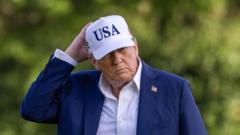The postponement of tariffs shines a light on the challenges facing the Trump administration in securing trade deals at a critical juncture.
Trump Postpones Tariff Implementation Amid Global Trade Tensions

Trump Postpones Tariff Implementation Amid Global Trade Tensions
President Trump delays tariff decisions as international negotiations stall and trading partners push back.
In a surprising turn of events, President Donald Trump has pushed back the implementation of tariffs that had been anticipated to affect international trade dynamics significantly. Originally, the White House had boasted of "90 deals in 90 days," but as it stands, not even nine agreements are likely to materialize by the initial deadline of July 9. This latest delay, now extended to August 1, points to a mounting struggle for the Trump administration in negotiations with global trade partners.
Treasury Secretary Scott Bessent remarked that the administration is concentrating efforts on the 18 countries responsible for the bulk of America's trade deficit. Despite the upbeat narrative surrounding potential trade agreements, the administration seems to be grappling with its inability to finalize these deals. The letters dispatched to trading partners echo an earlier era of trade negotiations but reveal a stark reality: the expected 'reciprocal' tariffs are yet to be enacted, and the actual terms being offered are not much different from those presented in April.
Market responses have been relatively muted to the recent delays, with traders growing accustomed to the notion that President Trump may falter in his hardline promises. However, the international community has begun to exhibit a more assertive stance, evidenced by recent frustrations voiced by Japan and South Korea in response to U.S. trade measures. Japan's Finance Minister indicated that the country's substantial holdings of U.S. debt could be leveraged as a countermeasure against American trade tactics.
Despite the backdrop of tariff negotiations, the economic indicators portray a different narrative. Although predictions initially suggested a strengthening dollar would alleviate inflationary pressures linked to tariffs, the dollar has plummeted by 10% against various currencies this year. Indeed, this downturn demonstrates how the imposition of tariffs has affected U.S. trade patterns, with Chinese exports to the U.S. declining by 9.7% even as their overall global shipments, including to nations such as the UK, ASEAN countries, and Africa, have all seen significant rises.
This evolving trade landscape indicates that as the U.S. erects barriers, other countries are enhancing their trading relationships with one another, evident in recent agreements between the UK and India, as well as the EU and Canada. The U.S. is now imposing average effective tariffs of around 15%, a dramatic escalation from the historical rates of 2% to 4% seen over the past four decades. While markets remain calm for now, it remains to be seen how long this tranquility will last under the pressure of ongoing trade disputes.
Treasury Secretary Scott Bessent remarked that the administration is concentrating efforts on the 18 countries responsible for the bulk of America's trade deficit. Despite the upbeat narrative surrounding potential trade agreements, the administration seems to be grappling with its inability to finalize these deals. The letters dispatched to trading partners echo an earlier era of trade negotiations but reveal a stark reality: the expected 'reciprocal' tariffs are yet to be enacted, and the actual terms being offered are not much different from those presented in April.
Market responses have been relatively muted to the recent delays, with traders growing accustomed to the notion that President Trump may falter in his hardline promises. However, the international community has begun to exhibit a more assertive stance, evidenced by recent frustrations voiced by Japan and South Korea in response to U.S. trade measures. Japan's Finance Minister indicated that the country's substantial holdings of U.S. debt could be leveraged as a countermeasure against American trade tactics.
Despite the backdrop of tariff negotiations, the economic indicators portray a different narrative. Although predictions initially suggested a strengthening dollar would alleviate inflationary pressures linked to tariffs, the dollar has plummeted by 10% against various currencies this year. Indeed, this downturn demonstrates how the imposition of tariffs has affected U.S. trade patterns, with Chinese exports to the U.S. declining by 9.7% even as their overall global shipments, including to nations such as the UK, ASEAN countries, and Africa, have all seen significant rises.
This evolving trade landscape indicates that as the U.S. erects barriers, other countries are enhancing their trading relationships with one another, evident in recent agreements between the UK and India, as well as the EU and Canada. The U.S. is now imposing average effective tariffs of around 15%, a dramatic escalation from the historical rates of 2% to 4% seen over the past four decades. While markets remain calm for now, it remains to be seen how long this tranquility will last under the pressure of ongoing trade disputes.




















